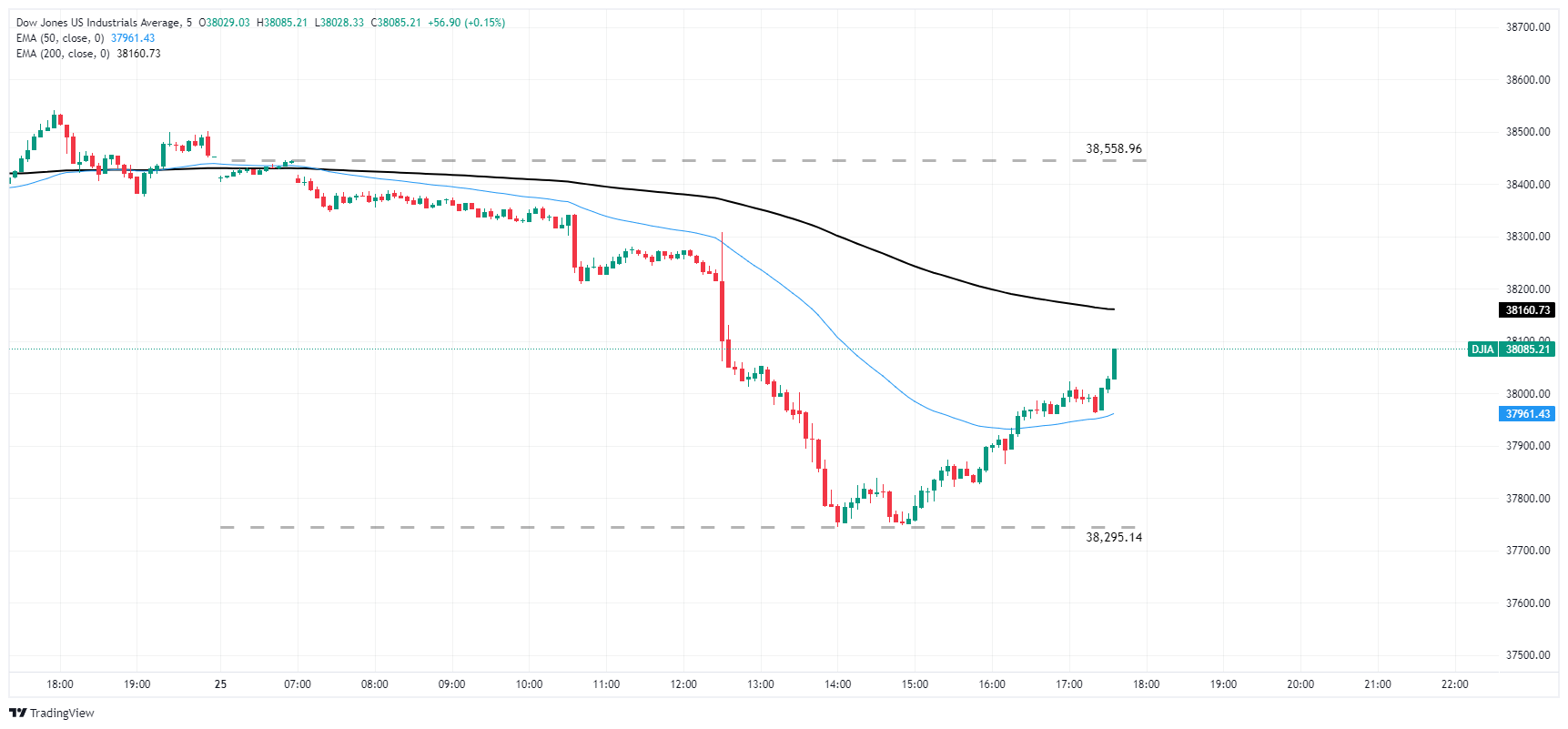- The Dow Jones falls more than 500 points as investors fear the complications of inflation.
- US GDP shrank faster than expected, sparking risk appetite.
- The stock recovery is underway, but remains limited.
The Dow Jones hit its lowest level in a week after US Gross Domestic Product (GDP) numbers missed forecasts and US core personal consumption expenditure (PCE) inflation came in higher as expected. Slowing growth favors investors looking for an accelerated path of rate cuts from the Federal Reserve (Fed), but persistent inflation continues to dash hopes of an early rate cut by the Fed.
Annualized first-quarter US GDP grew 1.6%, well below the expected decline to 2.5% from 3.4% previously. It represents the slowest pace of GDP growth since September 2022. First-quarter core PCE rebounded to 3.7%, up from 2.0% previously and beating the 3.5% forecast. Headline PCE inflation also beat forecasts, standing at 3.4% versus 1.8% previously, as inflation remains higher than investors expected.
Dow Jones News
The Dow Jones plummeted into negative territory for the week, falling below 37,800 and retreating more than 550 points on poor US data. A slow recovery is underway in the US trading session, but the Dow Jones remains firmly off the day's highs, with bids near 38,450.
About two-thirds of the individual stocks that make up the Dow Jones are in the red on Thursday, with International Business Machines Corp. (IMB) leading the charge lower. IBM is down more than 8% at the time of writing, to $168.77 per share. IBM is closely followed by Caterpillar Inc. (CAT), which is down about 6.5% on the day and is trading near $340.12. The DJIA's biggest gainer on Thursday is Merck & Co Inc. (MRK), which is up almost 3% and trading at $130.63 per share.
Dow Jones Technical Outlook
The Dow Jones fell 1.82% on Thursday, hitting a seven-day low of 37,745.54 and turning negative for the week. Despite major equity indices recovering nearly half of the day's declines, the DJIA remains well off the day's highs at 38,446.43.
Even though the Dow Jones is on track for its second straight day of decline, the index remains firmly planted in the bullish zone, trading well above the 200-day EMA at 36,700.41.
Dow Jones Five Minute Chart
Frequently Asked Questions About the Dow Jones
The Dow Jones Industrial Average, one of the world's oldest stock indices, is made up of the 30 most traded securities in the United States. The index is price-weighted rather than capitalization-weighted. It is calculated by adding the prices of the securities that comprise it and dividing them by a factor, currently 0.152. The index was founded by Charles Dow, also founder of the Wall Street Journal. In recent years it has been criticized for not being sufficiently representative, as it only tracks 30 conglomerates, unlike broader indices such as the S&P 500.
There are many factors that influence the Dow Jones Industrial Average (DJIA). The main one is the aggregate performance of its component companies, revealed in the companies' quarterly earnings reports. US and global macroeconomic data also contribute, influencing investor sentiment. The level of interest rates, set by the Federal Reserve (Fed), also influences the DJIA, as it affects the cost of credit, on which many companies largely depend. Therefore, inflation can be a determining factor, as well as other parameters that influence the Fed's decisions.
The Dow Theory is a method for identifying the main trend of the stock market developed by Charles Dow. A key step is to compare the direction of the Dow Jones Industrial Average (DJIA) and the Dow Jones Transportation Average (DJTA) and only follow trends where both are moving in the same direction. Volume is a confirmation criterion. The theory uses elements of maximum and minimum analysis. Dow theory postulates three trend phases: accumulation, when the smart money starts buying or selling; public participation, when the general public joins in; and distribution, when the smart money comes out.
There are several ways to trade the DJIA. One is to use ETFs that allow investors to trade the DJIA as a single security, rather than having to buy shares of the 30 companies that comprise it. A prominent example is the SPDR Dow Jones Industrial Average ETF (DIA). DJIA futures contracts allow speculation on the future value of the index, and options give the right, but not the obligation, to buy or sell the index at a predetermined price in the future. Mutual funds allow investors to purchase a portion of a diversified portfolio of DJIA securities, providing exposure to the global index.
Source: Fx Street
I am Joshua Winder, a senior-level journalist and editor at World Stock Market. I specialize in covering news related to the stock market and economic trends. With more than 8 years of experience in this field, I have become an expert in financial reporting.







